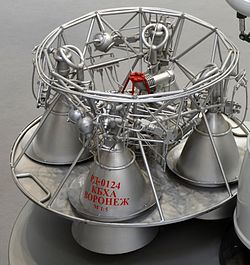
Soyuz is a family of expendable Russian and Soviet carrier rockets developed by OKB-1 and manufactured by Progress Rocket Space Centre in Samara, Russia. With over 1,900 flights since its debut in 1966, the Soyuz is the most frequently used launch vehicle in the world as of 2021.

A liquid-propellant rocket or liquid rocket utilizes a rocket engine that uses liquid propellants. Liquids are desirable because they have a reasonably high density and high specific impulse (Isp). This allows the volume of the propellant tanks to be relatively low. It is also possible to use lightweight centrifugal turbopumps to pump the rocket propellant from the tanks into the combustion chamber, which means that the propellants can be kept under low pressure. This permits the use of low-mass propellant tanks that do not need to resist the high pressures needed to store significant amounts of gasses, resulting in a low mass ratio for the rocket.

The Angara rocket family is a family of launch vehicles being developed by the Moscow-based Khrunichev State Research and Production Space Center. The launch vehicles are to put between 3,800 kg (8,400 lb) and 24,500 kg (54,000 lb) into low Earth orbit and are intended, along with Soyuz-2 variants, to replace several existing launch vehicles.

The staged combustion cycle is a power cycle of a bipropellant rocket engine. In the staged combustion cycle, propellant flows through multiple combustion chambers, and is thus combusted in stages. The main advantage relative to other rocket engine power cycles is high fuel efficiency, measured through specific impulse, while its main disadvantage is engineering complexity.

The gas-generator cycle is a power cycle of a pumped liquid bipropellant rocket engine. Part of the unburned propellant is burned in a gas generator and the resulting hot gas is used to power the propellant pumps before being exhausted overboard, and lost. Because of this loss, this type of engine is termed open cycle.
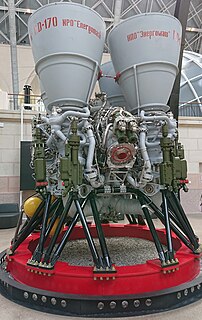
The RD-170 is the world's most powerful and heaviest liquid-fuel rocket engine. It was designed and produced in the Soviet Union by NPO Energomash for use with the Energia launch vehicle. The engine burns kerosene fuel and LOX oxidizer in four combustion chambers, all supplied by one single-shaft, single-turbine turbopump rated at 170 MW (230,000 hp) in a staged combustion cycle.
The RD-8 is a Soviet / Ukrainian liquid propellant rocket engine burning LOX and RG-1 in an oxidizer rich staged combustion cycle. It has a four combustion chambers that provide thrust vector control by gimbaling each of the nozzles in a single axis ±33°. It was designed in Dnipropetrovsk by the Yuzhnoye Design Bureau as the vernier thruster of the Zenit second stage. As such, it has always been paired with the RD-120 engine for main propulsion.

NPO Energomash “V. P. Glushko” is a major Russian rocket engine manufacturer. The company primarily develops and produces liquid propellant rocket engines. Energomash originates from the Soviet design bureau OKB-456, which was founded in 1946. NPO Energomash acquired its current name on May 15, 1991, in honor of its former chief designer Valentin Glushko.
RD-270 (Russian: Раке́тный дви́гатель 270, Rocket Engine 270, 8D420) was a single-chamber liquid-bipropellant rocket engine designed by Energomash (USSR) in 1960–1970. It was to be used on the first stages of proposed heavy-lift UR-700 and UR-900 rocket families, as well as on the N1. It has the highest thrust among single-chamber engines of the USSR, 640 metric tons at the surface of Earth. The propellants used are unsymmetrical dimethylhydrazine (UDMH) and nitrogen tetroxide (N2O4). The chamber pressure was among the highest considered, being about 26 MPa. This was achieved by applying full-flow staged combustion cycle for all the incoming mass of fuel, which is turned into a gas and passes through a couple of turbines before being burned in the combustion chamber. This allowed the engine to achieve a specific impulse of 301 s (2.95 km/s) at the Earth's surface.
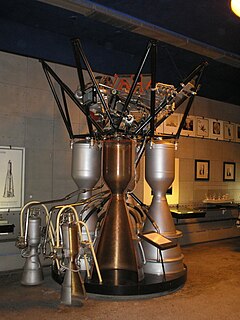
The RD-107 and its sibling, the RD-108, are a type of rocket engine initially used to launch R-7 Semyorka missiles. RD-107 engines were later used on space launch vehicles based on the R-7. As of 2021, very similar RD-107A and RD-108A engines are used to launch the Soyuz-2.1a, and Soyuz-2.1b, which are in active service.
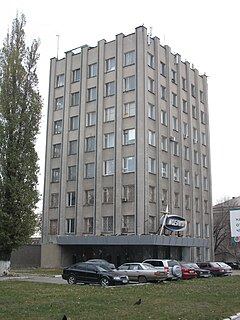
Chemical Automatics Design Bureau (CADB), also KB Khimavtomatika, is a Russian design bureau founded by the NKAP in 1941 and led by Semyon Kosberg until his death in 1965. Its origin dates back to a 1940 Moscow carburetor factory, evacuated to Berdsk in 1941, and then relocated to Voronezh city in 1945, where it now operates. Originally designated OKB-296 and tasked to develop fuel equipment for aviation engines, it was redesignated OKB-154 in 1946.
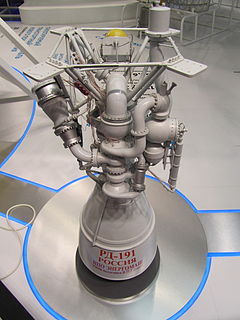
The RD-191 is a high-performance single-combustion chamber rocket engine, developed in Russia. It is derived from the RD-180 dual-combustion chamber engine, which itself was derived in turn from the four-chamber RD-170 originally used in the Energia launcher.
RD-0410 was a Soviet nuclear thermal rocket engine developed by the Chemical Automatics Design Bureau in Voronezh from 1965 through the 1980s using liquid hydrogen propellant. The engine was ground-tested at the Semipalatinsk Test Site, and its use was incorporated in the Kurchatov Mars 1994 crewed mission proposal.
Universal Rocket Module (URM) is the name of the modular liquid fuelled first and second stage of the Angara expendable launch system. The first stage and booster variant is referred to as URM-1, while the second stage is referred to as URM-2. The URM-2 is derived from the Soyuz-2 Block I second stage.
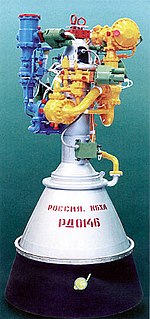
The RD-0146 is a liquid-fuel cryogenic rocket engine developed by KBKhA Kosberg in Voronezh, Russia.

Rocket propellant is the reaction mass of a rocket. This reaction mass is ejected at the highest achievable velocity from a rocket engine to produce thrust. The energy required can either come from the propellants themselves, as with a chemical rocket, or from an external source, as with ion engines.
The RD-193 is a high performance single-combustion chamber rocket engine, developed in Russia from 2011 to 2013. It is derived from the RD-170 originally used in the Energia launcher.
The flight of Angara-1.2pp was the maiden flight of Russia's Angara series of rockets. This flight was conducted successfully on 9 July 2014. A unique configuration with parts taken from the Angara-1 and Angara-A5 rockets, the suborbital mission served to flight test each of the new stages developed for the rocket ahead of its operational use.

The RD-0110 is a rocket engine burning liquid oxygen and kerosene in a gas generator combustion cycle. It has four fixed nozzles and the output of the gas generator is directed to four secondary vernier nozzles to supply vector control of the stage. It has an extensive flight history with its initial versions having flown more than 57 years ago.
The Soyuz-7 or Amur is a partially-reusable, methane–fueled, orbital launch vehicle currently in the design concept stage of development by the Roscosmos State Corporation in Russia. Design began by 2020, with operational flights planned for no earlier than 2026. Amur is intended to substitute for the existing Soyuz-2, at a much lower per launch cost.
